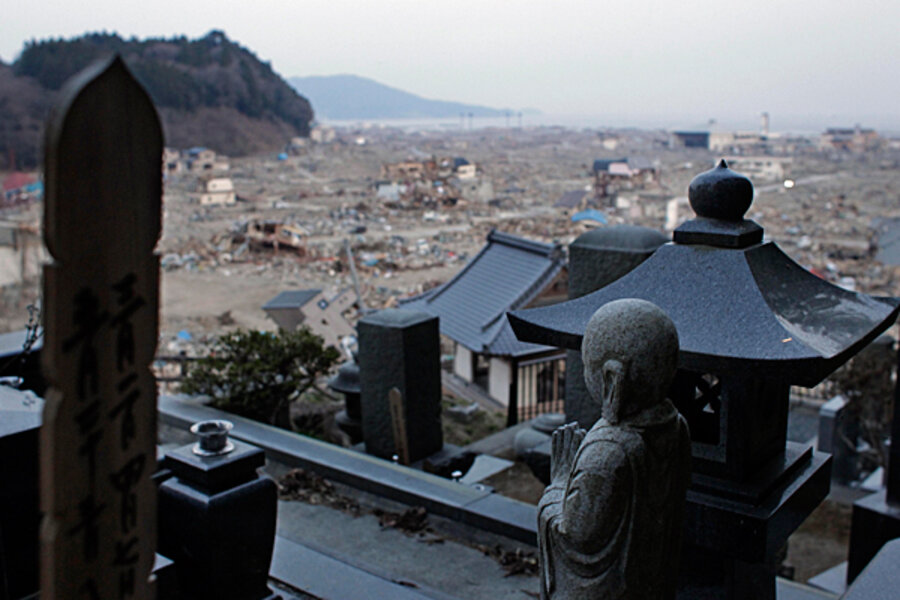Rebuilding Japan after the tsunami - one soy sauce business at a time
Loading...
| Rikuzentakata, Japan
“I’m Kono of Yagisawa Shoten.” The baritone delivery is confident, and accompanied by a smile that belies a tragedy repeated countless times along Japan’s northeast coast.
As his hometown of Rikuzentakata, in Iwate prefecture, comes to terms with the deaths of more than 2,000 people and the loss of 80 percent of its homes, Michihiro Kono hopes to rebuild his historic soy sauce business and instill hope in fellow residents.
The recent construction of the first temporary housing units is a sign the town is looking forward, but the rehousing effort is expected to take months to complete. Kono has been president of Yagisawa Shoten for less than a month, having asked his father’s permission to take over the family firm following the disaster. His goal is to guide the business – and the community surrounding it – through the most tumultuous time in its 207-year history.
The plant where nine generations of his family have made premium soy sauce and miso, staples of the Japanese diet, lies in ruins. All that is left is a pressing machine, which still gives off the smell of soy sauce, mixing in the air with that of rotten debris and seawater.
But outside the prefabricated hut on higher ground where Kono and his 45 employees are regrouping, stand several dozen full bottles of his signature product retrieved from the rubble.
"There is no doubt in my mind that we will be back in business," says Kono, whose wife and three young children survived. "My family has been making soy sauce in Rikuzentakata since the Edo era [1603-1868], and we owe it to our customers to get back on our feet."
Paying jobs and rebuilding homes
While thousands of people have no jobs to return to, he has continued to pay his staff from his savings, and even arranged a welcome party for two new recruits.
Despite the stream of requests for soy sauce – some accompanied by cash to fund the firm’s renaissance – Kono concedes it will be at least five years before Yagisawa is delivering its own products.
“We need to rebuild the factory first,” he says. “And it takes a long time to produce soy sauce and miso, up to two years for some items.”
A big part of that effort will depend on how the re-housing operation in Rikuzentakata goes. To date, 36 temporary housing units have been built in the town, a fraction of the 4,000 units needed for the estimated 7,000 residents living in shelters in the town.
They include Yukie Sato, who is living in a school gymnasium with her young son and mother. Her husband, a local government official, returned to work immediately after the tsunami.
"Even if we get rent-free temporary housing, we will still have to pay the bills and buy food," she says. "I don't know how it will all work out. My car was swept away, my workplace has gone, and we have no money.”
Hurdles to the rebuilding effort
Across the three worst-affected prefectures – Iwate, Miyagi, and Fukushima – the operation to re-house evacuees is being held up by the high cost of materials, a shortage of engineers to install gas, water, and electricity, and a lack of flat land on higher ground.
The government estimates 72,000 prefabricated homes are needed in the region, but as of last week only 395 had been erected. To compound the problem, space for 41,000 units has yet to be secured.
Each unit costs about 2.4 million yen ($28,000) to build; it takes three weeks to complete 120 units. But the pace of construction is slower than that following the Kobe earthquake in 1995, when more than 48,000 units were built within seven months.
“The prefectural government will continue to build them as quickly as possible so we can get people into a place where they can sleep comfortably and have space in which to rebuild their lives,” says Tomoyuki Murakami, a Rikuzentakata town official.
The fortunate few who have secured a prefab by lottery will be permitted to stay in them for up to two years, but must pay gas and other utility bills. Each home has electricity, running water, a small bath and toilet, a microwave, and a TV.
“My mother and I have applied separately for temporary housing and are waiting for the results. We’re hoping for the best,” says Sato.
While the provision of supplies, gas, and electricity has improved vastly in recent weeks, Sato and her 135,000 fellow evacuees have to contend with cramped conditions and fears concerning their livelihoods.
“I haven’t been able to sleep well and am very tired,” she says. “But this is better than other evacuation centers. We aren’t in need of anything in particular. I’m more worried about finding work and how we are going to live. When I think about the future, the answers don’t come.”
Katsunari Sasaki, a retired electrician, has returned to what is left of his home to collect a few mementos that may be all that is left of his family’s life pre-tsunami.
“It’s way too early to think about the future,” says Mr. Sasaki. “I’ve applied for temporary housing but only a few places have been built so far. Construction firms are among the victims, so it’s going to be months before we can leave the evacuation center.”
He adds: “I don’t want to live around here anymore. And I’m not alone.”
The debate over where to rebuild homes – near the coast or on higher land – for Rikuzentakata’s dispossessed has barely begun. Wherever they re-emerge, Kono is determined that his soy sauce plant will again be at the heart of the town’s commercial life.
“This company is 200 years old,” he says. “If we want it to last another 200 years, this is a turning point."





